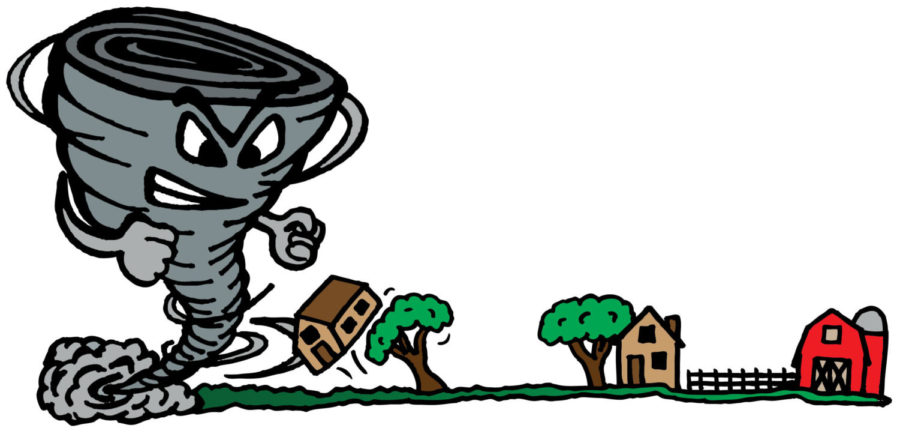Tornado season has begun
Illustration: Ryan Francois/Iowa State Daily
Tornado season winds its way to Iowa and the rest of the Tornado Alley.
March 22, 2012
The wail of a tornado siren is something most Iowans have heard, as Iowa is smack dab in the middle of “Tornado Alley” — a hotbed of several Midwestern states comprising a notoriously deadly tornado zone.
Tornado season, loosely classified as lasting from late spring to early fall, has already begun with a bang.
Earlier this month, several dozen tornadoes ripped through the American heartland and southern region, killing at least 39 people and injuring countless others. Disaster relief organizations are mobilizing to provide aid to the affected towns.
Statistically speaking, Tornado Alley sees tornadoes more frequently than anywhere in the world. According to the National Climatic Data Center, an average of 1,253 tornadoes occur in the United States each year.
William Gallus, professor of geological and atmospheric sciences, explained why the North American heartland climate produces so many tornadoes.
“The warm Gulf of Mexico allows south winds to bring a lot of moisture northward, and the high elevation deserts of the American Southwest allow a warm layer to drift over the Plains about a mile up,” Gallus said. “This warm layer acts like a lid, letting tremendous instability and energy build up below it, so that when it gets hot and humid enough, or something lifts the air, it explodes through the lid and air rushes upward with more violence than just about anywhere else on the planet.”
Nearly all tornadoes reported in the United States are considered to be relatively small and short lived — 95 percent of all tornadoes produce winds less than 100 mph and last only five to 20 minutes, causing few if any fatalities.
But every now and then, a violent beast of a storm emerges from the sky, shredding through rural towns and settlements with winds exceeding 200 mph. Such was the case for the infamous 1925 “Tri-State Tornado,” a category F5 tornado that ravaged through Missouri, Illinois and Indiana, causing 695 deaths — the deadliest tornado ever recorded in U.S. history.
Iowa has never experienced such widespread disaster as the Tri-State Tornado — the highest death toll ever reported by a single tornado in Iowa was on March 15, 1968, claiming 13 lives.
Tornadoes are highly unpredictable phenomena, so climatologists say it is hard to say exactly what lies ahead for the 2012 tornado season. However, there are some climatic factors that may suggest an increase in tornado activity this year.
“The Gulf of Mexico is warmer than normal since there was almost no winter weather down there this year,” Gallus said. “With the water being warmer, winds can sweep larger amounts of moisture off the Gulf and bring it north, which creates more fuel for thunderstorms and tornadoes.”
There is overwhelming evidence to suggest that Earth’s climate is changing. Some scientists are wondering if global warming might lead to a dramatic increase in extreme weather events.
Over the last decade, an influx of mega-hurricanes has already been seen across the globe. These disasters are completely natural and have been occurring for millions of years.
But problems arise when hurricanes and tornados attack densely populated areas, causing fatalities and costly damage. Hurricane Katrina, for example, was widely regarded as one of the worst natural disasters in U.S. history. It took the lives of 1,836 New Orleans citizens, and cost the government over $81 billion in damages.
Many scientists, like Gallus, agree that these unusual weather patterns could be closely connected to a rising global temperature.
“The evidence for warming temperatures over the planet is pretty much undeniable,” Gallus said. “Warmer weather near the ground is one ingredient that should increase both hurricanes and tornadoes.”
Scientists say that while it is clear that our climate is changing, it must be noted that any correlation between climate change and an increase in severe weather is only hypothetical. Tornadoes and hurricanes are still very unpredictable phenomena.
People in the Midwest live under constant threat of tornadoes almost year-round.
Harry Hillaker, state climatologist for the Iowa Department of Agriculture and Land Stewardship, is well aware of Iowa’s potential for destructive tornadoes.
“The historical record shows that tornadoes have occurred in Iowa in every month of the year,” Hillaker said. “We have even had one major outbreak in January of 1967. May and June are by far the most likely months of the year for tornadoes in Iowa.”
Scientists and disaster prevention organizations alike agree it is essential to know safety protocols in order to sidestep the destructive path of a tornado.
In the event of a tornado, people are told to always occupy the lowest possible ground, and avoid taking cover near windows at all costs. The proper protocol is to crouch to the ground with their hands over their head. The next tornado could be looming just around the corner, so be prepared.

















